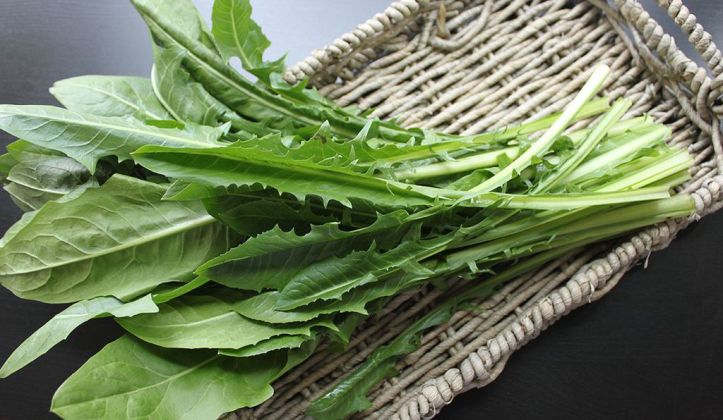
Dandelions come up in the early spring, just when our bodies are due for a spring clean ing. When consumed, the dandelion’s defining characteristic is bitterness, and this is the very feature that lends it restorative properties. That bitterness is medicine derived from plant acids and healing alkaloids. Dandelions shake you out of hibernation, getting your blood pumping and your organs cleaning house from radiation, toxic heavy metals, DDT, and other poisons.
What makes the dandelion unique is that every part of the plant can be used: root, leaves, flower, and even stem. Each bit has a different degree of bitterness, and this corresponds with areas of the body that need different sorts of cleansing.
Phyto-nutrients in dandelion leaves purify blood and also help bring it to hard-to-reach places, so the leaves are a must for circulatory issues such as poor circulation. The leaves’ bitterness is also geared to squeeze toxins out of the lymphatic system, making them ideal for addressing non-Hodgkin’s lymphoma, swollen lymph nodes, and edema.
When you get to the stem of the dandelion, which is even more bitter than the flower and leaves, now you’re in the world of cleansing the dense organs such as the spleen, liver – for example, by pushing out bile that’s no longer useful
And when you get to the dandelion root, you’re detoxifying even deeper into those dense organs. This is the bitterest part of the plant, and it forces the organs to purge on the deepest level for an intensified purification. When it comes to detoxing, dandelion root is not for the faint of heart.
Dandelion is not just a cleansing herb. It’s like a housekeeping service at a fancy hotel that, after tidying up and gathering the trash, leaves a mint behind on your pillow. Dandelion’s parting gift is better than candy – it leaves behind vital nutrients such as vitamin A, B vitamins, manganese, iodine, calcium, iron, magnesium, selenium, silica, and chlorophyll that give you energy and help your body stave off disease. Dandelion is a preventative for virtually any illness, and is especially great for the prostate.
| PRIMARY MICRO NUTRIENTS | |
| SECONDARY MICRO NUTRIENTS | Vitamin B3, Folate |
| NUTRITIONAL HIGHLIGHTS and NOTES |
|
| FUNCTIONAL BENEFITS |
|
| PHYTONUTRIENTS | Guaianolide Taraxacin – intestinal anti-septic, germicidal, expectorant |
| PLANT FAMILY | Compositae, Daisy / Sunflower. Related to: Artichoke, Jerusalem Artichoke (Sunchoke), Lettuce |
| DANGERS |
|
| RDA | Dandelion | % RDA | ||
| Nutrient | Unit | per 100g | ||
| Water | g | 3700 | 85.6 | 2.3% |
| Energy | kcal | 2600 | 45 | 1.7% |
| Protein | g | 90 | 2.7 | 3.0% |
| Total lipid (fat) | g | 87 | 0.7 | 0.8% |
| Carbohydrate, by difference | g | 224 | 9.2 | 4.1% |
| Fiber, total dietary | g | 38 | 3.5 | 9.2% |
| Sugars, total | g | 0.71 | ||
| Minerals | ||||
| Calcium, Ca | mg | 1000 | 187 | 18.7% |
| Iron, Fe | mg | 8 | 3.1 | 38.8% |
| Magnesium, Mg | mg | 420 | 36 | 8.6% |
| Phosphorus, P | mg | 700 | 66 | 9.4% |
| Potassium, K | mg | 470 | 397 | 84.5% |
| Sodium, Na | mg | 76 | ||
| Zinc, Zn | mg | 11 | 0.41 | 3.7% |
| Copper, Cu | mg | 0.9 | 0.171 | 19.0% |
| Manganese, Mn | mg | 2.3 | 0.342 | 14.9% |
| Selenium, Se | µg | 55 | 0.5 | 0.9% |
| Vitamins | ||||
| Vitamin C, total ascorbic acid | mg | 90 | 35 | 38.9% |
| Thiamin | mg | 1.2 | 0.19 | 15.8% |
| Riboflavin | mg | 1.3 | 0.26 | 20.0% |
| Niacin | mg | 16 | 0.806 | 5.0% |
| Pantothenic acid | mg | 5 | 0.084 | 1.7% |
| Vitamin B-6 | mg | 1.7 | 0.251 | 14.8% |
| Folate, total | µg | 400 | 27 | 6.8% |
| Choline, total | mg | 35.3 | ||
| Betaine | mg | |||
| Vitamin B-12 | µg | 2.4 | 0 | 0.0% |
| Vitamin A, IU | IU | 5000 | 10161 | 203.2% |
| Vitamin E, total | mg | 15 | 3.44 | 22.9% |
| Vitamin D | IU | 600 | 0 | 0.0% |
| Vitamin K (phylloquinone) | µg | 120 | 778.4 | 648.7% |
RDA – Recommended Dietary Amount recommendations are based upon calculations for a 40 year old very active man that I have adapted from USDA’s Dietary Intake Guidelines. Using this link you can make your own calculations
Adapted from:
Murray, M. (2005). Encyclopedia of Healing Food. New York, N.Y.: Atria Books
USDA food database: http://ndb.nal.usda.gov/ndb/
Other information sources:
World’s Healthiest Foods – an excellent online food and nutrition encyclopedia

[…] Vegetable – Beets and Brassica family vegetables (eg cabbage, broccoli and brussel sprouts). Green leaf vegetables (eg kale) are particularly beneficial to liver health, especially sour leaves like dandelion leaves […]
LikeLike